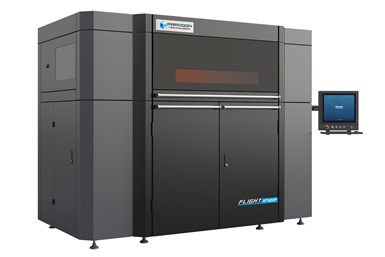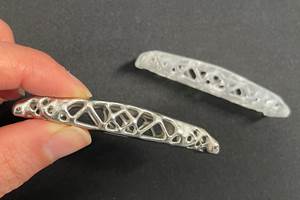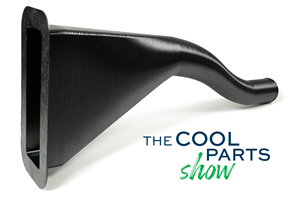Farsoon Flight 403P Dual-Laser Platform Offers High-Temp Plastic LPBF
Formnext 2023: Farsoon’s 403P Series offers a versatile, powerful platform for plastic laser sintering that can achieve two full industrial-scale builds (cylinder size 400 × 400 × 540 mm) within 24 hours.
Share
Farsoon’s Flight 403P Dual-Laser Platform series is a high-temperature plastic laser powder bed fusion (LPBF) platform. As one of the first machine manufacturers to develop production-targeted LPBF systems using industrial fiber lasers, Farsoon introduced the development of the dual-laser configuration of Flight (Fiber laser) technology and its application on the 403P platform.
Boosting significantly 3-4 times production yield compared to a single CO2 laser SLS machine, the dual laser Flight 403P system can achieve two full industrial-scale builds (cylinder size 400 × 400 × 540 mm) within 24 hours. The advanced features include removable cartridges and an external cooling station which can further improve the machine uptime and create higher throughput with the same footprint.
With robust laser power, improved energy distribution to the material and smaller laser spot size, Flight Technology is able to achieve the full sintering of powder in a significant short amount of time. It was developed to address the requirements of industrial-scale series production using LPBF technology, increasing the manufacturing turnover rate and accelerating the product-to-market cycles. The dual-laser configuration for Flight technology takes advantage of two powerful 300-W fiber lasers and two dynamic optical systems, creating two ultrafine laser spots with fast scanning speed of up to 20 m/sec (66 ft/sec) for each.
Equipped with powerful fiber lasers in place of standard CO2 lasers, the Flight 403P-2 Series is capable of delivering greatly increased power to the powder bed. Due to the more robust and stable nature of a fiber laser system, Flight Technology also provides improved laser longevity which is key when considering ROI for manufacturing applications.
Like all Farsoon systems, the Flight 403P-2 Series is offered with fully open machine parameters and unlocked material choices. With its increased power and energy absorption characteristics, Flight Technology is capable of accessing a much different range of processable materials and operational flexibility as compared to standard laser sintering systems, which enables increased freedom for future AM material and application development. Customers can freely choose materials for their application according to the specific needs of end-users. Also, Farsoon works with a fleet of global chemistry providers in validation of their high-performance, specialty engineering materials for fiber laser technology.
To further increase the manufacturing turnover rate, the dual-laser configuration for Flight technology takes advantage of two powerful 300-W fiber lasers and two dynamic optical systems, creating two ultrafine laser spots with fast scanning speed. The new dual-laser configuration can offer significantly 50-90% higher production volume rate compared to the single-laser configuration of Flight Technology, and 3 to 4 times production yield compared to a single CO2 laser machine.
The optimal performance of the Flight 403P-2 Series — combining extreme sintering speed and high feature resolution — can open up many potential markets and applications for true series production, such as electronic components, robotics, specialized tools and models, battery units, filter modules as well as many consumer products.
- Learn about Farsoon’s LPBF Systems for large-scale metal additive manufacturing. The FS621M Pro-4, FS621M Pro-6 and FS621M-U-4 systems are said to offer huge potential in aerospace applications by lowering operational cost and enabling true industrial-scale series manufacturing.
- Here’s an even larger Farsoon printer. Read about the Farsoon FS1521M which has 16 lasers for large-format metal additive manufacturing. This metal 3D printing platform series offers advanced multilaser scanning strategies with optional modes for efficiency, quality or balanced performance for different manufacturing needs.
Related Content
How to Build 10,000+ Shot Molds in Hours
Rapid tooling isn’t so rapid when it takes days to 3D print a metal mold, and then you still must machine it to reach the necessary tolerances. With Nexa3D’s polymer process you can print a mold in hours that is prototype or production ready and can last for more than 10,000 shots.
Read MoreDrones Take Flight with Metal and Polymer 3D Printed Parts: The Cool Parts Show Bonus
Drones produced by Cobra Aero now incorporate many 3D printed parts made through laser powder bed fusion and Multi Jet Fusion processes.
Read MorePossibilities From Electroplating 3D Printed Plastic Parts
Adding layers of nickel or copper to 3D printed polymer can impart desired properties such as electrical conductivity, EMI shielding, abrasion resistance and improved strength — approaching and even exceeding 3D printed metal, according to RePliForm.
Read MoreAircraft Ducts 3D Printed in Composite Instead of Metal: The Cool Parts Show #68
Eaton’s new reinforced PEKK, tailored to aircraft applications, provides a cheaper and faster way to make ducts compared to formed aluminum.
Read MoreRead Next
At General Atomics, Do Unmanned Aerial Systems Reveal the Future of Aircraft Manufacturing?
The maker of the Predator and SkyGuardian remote aircraft can implement additive manufacturing more rapidly and widely than the makers of other types of planes. The role of 3D printing in current and future UAS components hints at how far AM can go to save cost and time in aircraft production and design.
Read More4 Ways the Education and Training Challenge Is Different for Additive Manufacturing
The advance of additive manufacturing means we need more professionals educated in AM technology.
Read More3D Printing Brings Sustainability, Accessibility to Glass Manufacturing
Australian startup Maple Glass Printing has developed a process for extruding glass into artwork, lab implements and architectural elements. Along the way, the company has also found more efficient ways of recycling this material.
Read More











.png;maxWidth=300;quality=90)












